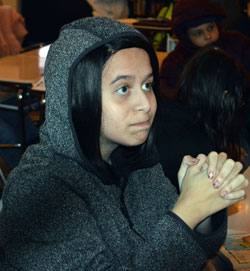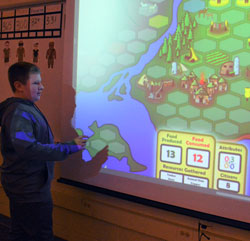Realizing the result could be a calamity of epic proportions, seventh graders prepared to spin a digital wheel projected on the classroom screen to unlock their next adventure.
Wyoming Junior High School teacher Brent VanEnk read possible events on which the spinner could land. “We have raid, natural disaster, merchant caravan, nomadic visitors, tribal invasion, attack of the goblins, the long winter, wizard duel, forced invasion, volcanic eruption, continental drift or obelisk of the shadow monger.
“Obelisk of the shadow monger,” he repeated. “That sounds horrifying, doesn’t it?”
With the push of a computer key, the spinner revolved. Alas, it stopped squarely on the foreboding obelisk space, prompting shouts of dread from the class. “Look in the middle of the utopia,” VanEnk said, laughing. “Something will be growing there.”
Welcome to VanEnktopia, where the history of civilizations is taught in Dungeons & Dragons-esque fashion with choose-your-own adventure twists and turns. While some of the components are for sheer enjoyment, the goal of the game is for students to work together to create a thriving civilization complete with economy, military and culture.
VanEnk began creating the mythical world during his first year teaching, four years ago. He said it’s consistently growing and morphing as different classes come up with new ideas. “It’s a mix between all sorts of video games,” he said. “We took these really popular and addictive video games and we made them into a student simulation.
“The unique thing is that kids help make it.”
Playing Out the Curriculum
The whole thing started, VanEnk said, because he wanted to engage his students and make teaching social studies as interesting as possible. The first concept — a wooden board game– evolved into the virtual world, complete with student-designed weaponry, animated characters and a yearlong battle between VanEnk’s four classes.
He designed the game to meet state seventh grade social studies standards, which begin at the start of humanity and end between the years 1400-1500. Students start with a primitive Stone Age society and make advances. If they do well enough, they end the year operating a large medieval village.
Student Jackson Lamrouex explained: “It helps us learn how it was in the beginning of time, how they started and how they advanced… It gives you something to look forward to. It’s exciting to see what plays out and what happens.”

Added Connor Arnold: “We learn how people formed what they did, how they got food and how they scattered to make larger civilizations.”
Each class starts out running their world as a democracy, with an elected student leader. “We talk about the democratic process,” VanEnk said. “They can have a representative that goes to Parliament if they want to go that route.”
Students cultivate their world through decisions they vote on as a class, shaping government, religion and commerce.
Because the game offers many learning opportunities, district math teachers have added elements and there are plenty of art and writing opportunities, like designing and writing about weapons. There’s a real cash register with paper currency for students to keep track of and save for their worlds. “They have a market where they can buy and sell potions and items for their character.”
Beyond that, they have a bull and bear market with resources, raw and refined, which serves as a lesson in economics, industry and agriculture.
“I’ve learned how our economy works, and back in the day what life was like,” said student Cassandra Boersma. “It reminds me of the (board game) Life, but backwards.”
Added Jayla White: “I learned how people used to craft and use things, the adventures you could go on back then and how an economy could spread with just a few things.”

Choose Your Own Language, Religion, Government
Students choose from six different fictitious religions that are similar to real religions, and also select a made-up language. Tribes resemble Native American Michigan tribes and adventures take place in Ancient Greece or other civilizations.
Things get really interesting when students learn about various government systems, VanEnk said. “When they study Europe, transitioning to a monarchy or communism becomes unlocked (as a game option). Communism is unique because they all share their homework grade. They aren’t a big fan of that … They almost always stay a democracy.”
Sometimes, VanEnk said, situations mirror current events. Recently, the class voted to impeach a leader for bribery.
“It’s about these real-world things that kids typically would just talk about. They play them out.”
Each class names its virtual “hero,” a warrior, wizard, rogue or bard, to lead their civilization. Progress is determined by a combination of game choices and actual tests and homework scores. Points are given in separate categories. Good grades on classroom tests and quizzes help students advance levels and earn points.
Scores are combined into a big number, and the class with the highest overall is declared the winner at the end of the school year.

VanEnk’s World
Evidence of the alternate universe is everywhere in the classroom, from the Viking-like characters on the walls and signs that say “scribes”, “wanderers” and “globemasters”. Students talk eagerly about levels, points and where they stand amongst other classes.
They are always awaiting the next adventure.
Recently, they faced one more battle just before dismissal (as if the obelisk of the shadow monger wasn’t enough to worry about). “You may pack up, but you are ready to fight a spider, so be ready to roll,” VanEnk, said moving a creepy arachnid along the screen.
The class took military action, voting to attack the spider rather than run and, luckily, proved successful in defeating it.
All was well, and VanEnk had accomplished his daily goal: “You sneak them into learning.”
CONNECT:
















